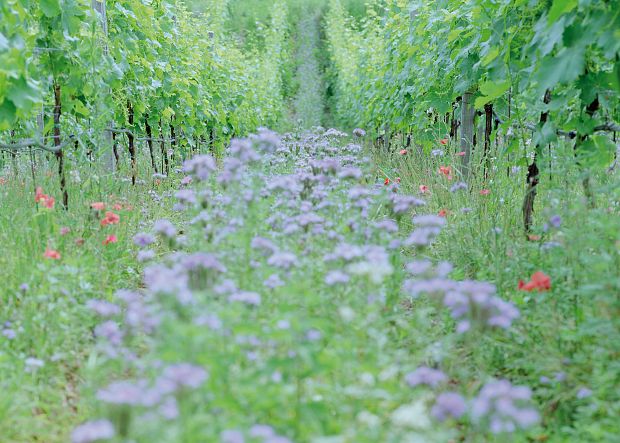The inside view
Biodynamics as a system for holistic health in viticulture
Helmuth Zozin - Director

Rudolf Steiner gifted us biodynamics as a holistic system for healthy crops. The basic idea of biodynamic agriculture is to strengthen all life forces in harmony and achieve synergistic interactions.
The beginnings of biodynamics
Almost a hundred years ago, farmers with an interest in anthroposophy asked Rudolf Steiner to do something for the ailing agricultural sector. Around and after the turn of the century, many farmers had noticed a deterioration in the reproductive forces of the crops and the quality of their produce.
This biological decline was due to the increasing use of inorganic fertilizers, and the anthroposophical farmers were so worried that they asked Rudolf Steiner to help. After much pleading, he presented the fundamentals of anthroposophical agriculture on Count Keyserlingk’s estate in Koberwitz, in what is now Poland, during the week of Pentecost in 1924.
During an eight-day series of talks attended by about a hundred farmers, Rudolf Steiner explained the workings of the living forces of nature and then presented his concept for improving agriculture and restoring the health of the land.
We may have difficulty with the fact that his instructions and preparations were based on his clairvoyant insights, but they have shown themselves to be effective in the field worldwide, and that is what counts. Farmers in particular are practical people with a critical eye for the results of any measures taken.
The work on the land is hard enough, and farmers certainly do not want it to be in vain. They only show pleasure and perseverance in their work when they find it meaningful. Biodynamic agriculture has proven itself and is now well established. Today it is practiced on over 160,000 hectares in 60 countries worldwide.

Biodynamics in viticulture
With its rigorous demands in terms of quality and the fragility of the old European grape varieties, viticulture was an obvious application for the subtle effects of biodynamics.
Perfectly mature, healthy and highly aromatic grapes with thick, crisp skins are a prerequisite for first-class wines – plus the need for a perfect balance between sugar and acidity. The wine should be an expression of agricultural individuality: The soil, climate, vintage and not least the wine maker should determine the character of the wine.
In my eyes, the only way forward is organic cultivation on prime sites in combination with meticulous manual working. Biodynamics is the ultimate form of organic working. It does not make all else superfluous, but it creates a kind of connection between all positive forces to form a harmonious whole.
The importance of the preparations
Biodynamics is primarily associated with two field spray preparations: horn manure (500) and horn silica (501). In my opinion, they are not the basis but the ethereal crowning of biodynamics. Before these preparations are used to put the finishing harmonizing touches to the interaction of the forces of nature, a healthy, vital basic system must be created. In viticulture, everything depends on selecting the right grape variety for the location involved. A good match is essential; it is the first prerequisite for great terroir wines.

Vitality: the soil and biodiversity
The second prerequisite is vitality, of which there are two pillars: healthy soil and biodiversity. These two factors require constant attention in the vineyard.
Healthy soil depends on humus formation; humus brings the soil to life. Varied cover crops, annual applications of compost and gentle tillage help build up humus and improve the life of the soil. In such a soil, the roots of our vines can spread out and find everything they need to generate healthy growth. In a living soil our vines also cope better with prolonged periods of drought as well as heavy rainfall.
We promote biodiversity in the vineyard itself by constantly renewing the cover crop and maintaining maximum diversity. We also make the surroundings as natural as possible. Hedges, bushes, woods as well as domestic and wild animals play an important role in this context. Diversity is beneficial to the health of the vineyard in general.
A regulatory function on our part is nevertheless permitted and indeed required to keep everything within healthy limits. In the natural world, nothing is inherently bad; there can only be too much of one element in the wrong place at the wrong time. It is important to get a feeling for what is good for the beneficial synergies and in what measure.
The human touch
The third requirement is meticulous working on all the measures that need to be taken. In organic viticulture in particular, every operation must be performed at the right time and with the necessary skill. We do not have the tools of conventional agriculture available, which allow for subsequent corrective action.
Pruning, suckering, canopy management, selective manual harvesting – each step is crucial and calls for painstaking attention.
Pruning alone is an art in itself. What is basically a drastic intervention for the vine has to be performed with precision and sensitivity for the sap flow. One mistake with the secateurs can have fatal consequences in terms of the life of the vine.
In summary, it is all about the interplay of many factors, and about mindfulness with regard to the many small steps to be taken.